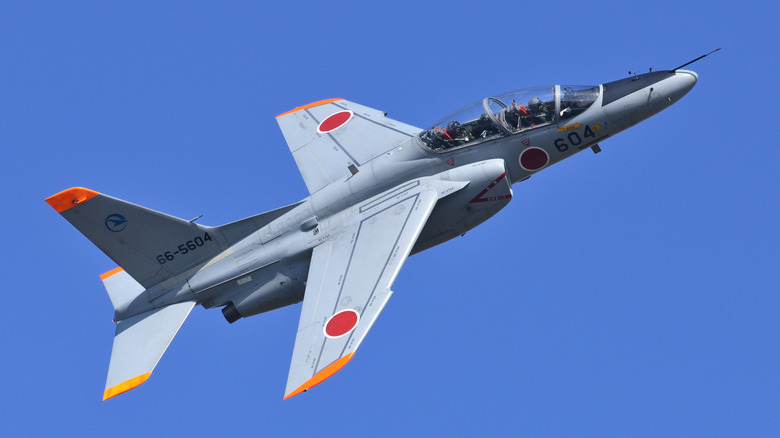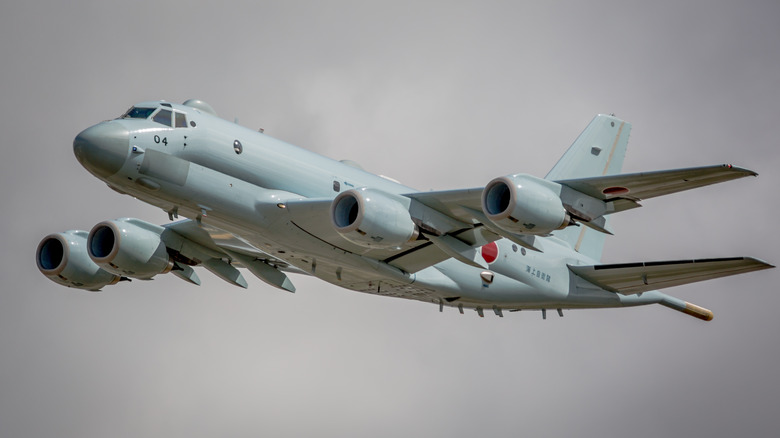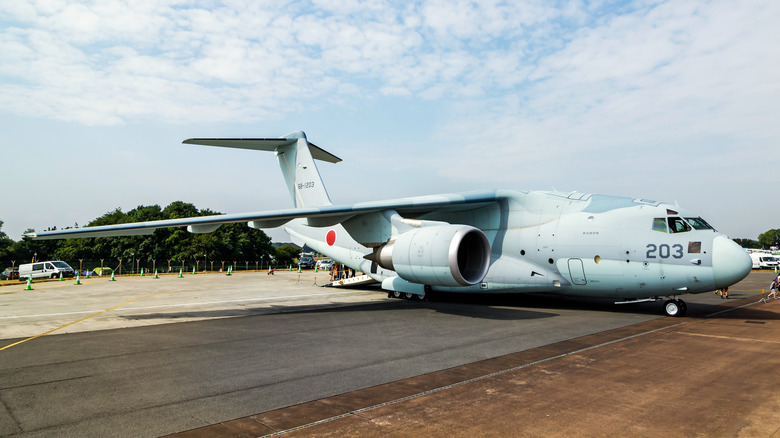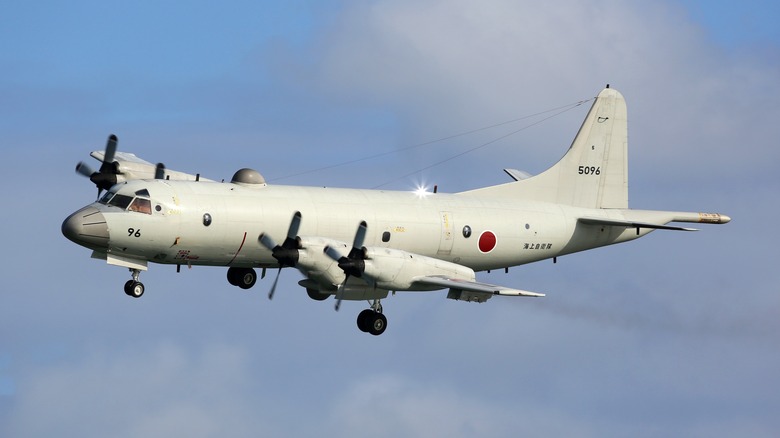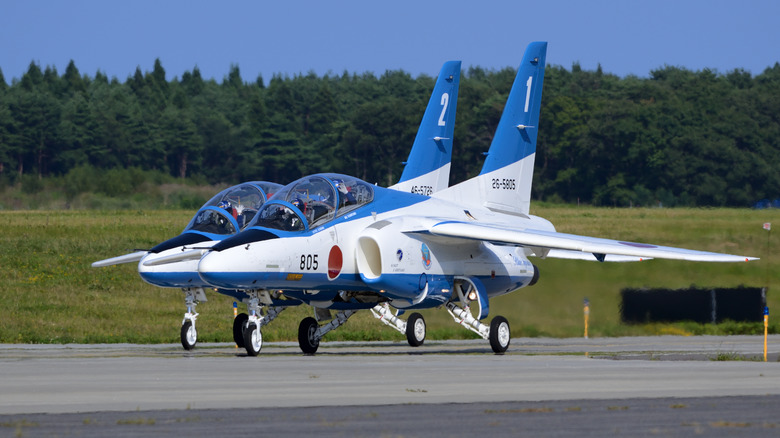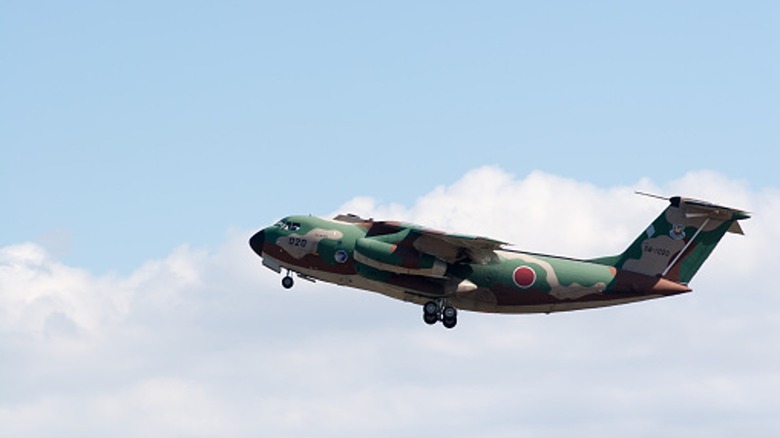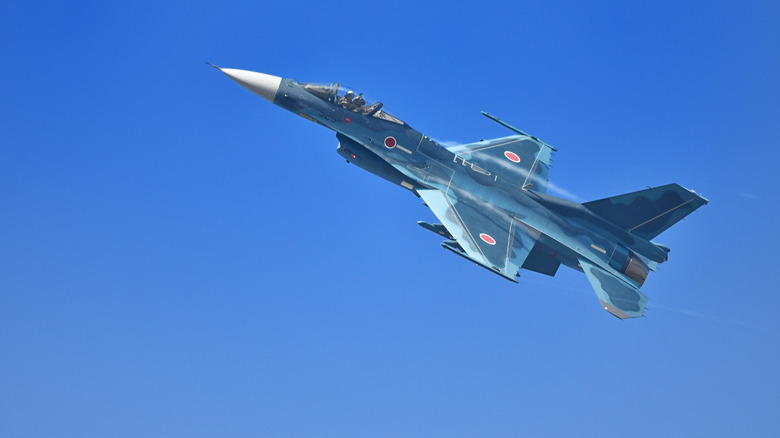5 Military Aircraft Built By Kawasaki
Kawasaki is a name anybody who dwells in the world of motorcycles will recognize. It's a Japanese automaker best known for its long line of Ninja motorcycles, but it also has a number of dirt bikes too. However, Kawasaki makes several products you might be surprised to learn about. Its manufacturing plants don't only produce motorcycles. The Japanese company also has been called on by the Japanese government to build airplanes from time to time. The company is also part of a team that assists with some rather well-known passenger planes, such as Boeing's 777. But Kawasaki's military planes are used regularly by the Japan Air Self-Defense Force (JASDF) and the Japan Maritime Self-Defense Force.
Kawasaki might not be making anything as glamorous as the F-35 fighter jet, but the planes it does make are vital to the protection of its nation. The automaker didn't only make a few planes either. It wasn't a "one-and done" kind of deal. It continues to manufacture various airplanes from transport crafts to training anti-submarine and patrol planes.
P-1 Maritime Patrol Aircraft
In 2007, the Kawasaki Aerospace Company created a patrol plane from scratch for its home country, meaning it's not based on a civilian aircraft. This plane is simply called the P-1 and it's designed for surveillance of the seas surrounding Japan. The P-1 has four turbofan engines that propel it at a speed of 538 knots and produce 13,000 pounds of force. Rather than use metal wiring that other planes use to connect their avionics, the P-1 has fiber optic wiring and is the first plane to do so. It's called a "fly-by-optics flight control system," and it reduces electro-magnetic disturbances that commonly affect fly-by-wire systems.
While Kawasaki built the fuselage, wings, and the rest of the body, Toshiba is behind the avionics. Other parts of the plane are designed by the American Honeywell Aerospace. Honeywell makes the auxiliary power unit, environmental and pressurization control systems, ram air turbine (RAT), and the sonobuoy dispensers. These systems help the P-1 complete its primary mission of detecting submarines. If it spots submarines, the plane is armed with torpedoes, depth charges, mines, bombs, and air-to-surface missiles. Kawasaki continues to manufacture the P-1 today.
C-2 Transport Aircraft
The military needs transport aircraft, commonly referred to as cargo planes, and Kawasaki has made two for the JASDF. Kawasaki developed the C-2 when the JASDF required a transport plane capable of carrying more than the C-1's max payload of 26,235 lbs. The C-2 had its maiden flight in 2016 and began its service for the Japanese in 2017 with a max payload of 82,893 lbs. — a significant improvement. Kawasaki claims the C-2's 8,864 cubic foot cargo hold makes it a versatile cargo plane capable of a transporting a wide variety of cargo. However, for reference, a C-5 Galaxy has over 34,000 cubic feet of cargo space in its hold.
While the C-2 is clearly no C-5 Galaxy, it does exactly what the Japanese need it to do and is a clear upgrade from its predecessor. Each of the C-2's two GE turbofan engines produce over 59,000 pounds of thrust with a max speed of 500 knots, but its typical cruising speed is closer to 480. It can travel a total of 5,400 nautical miles before its 11,360 gallon tank needs refueling.
Anti-Submarine Warfare (ASW) Patrol Aircraft
Being a powerful island nation makes one of Japan's biggest vulnerabilities submarines. They lurk below the waterline unseen and sneak up on their targets without warning. One of the best methods for counteracting a submarine is the use of an anti-submarine aircraft. Thus, Kawasaki produced a few anti-submarine aircraft for the Japan Maritime Self Defense Force over the years. Besides the P-1 patrol craft, Kawasaki also had the P-2J, which they started developing in 1963 and took its first flight in 1966. Kawasaki originally called it a P2V-7 "Kai," but changed its name mid production to P-2J.
Production of the P-2J stopped in 1971, but the Maritime Self Defense Force continued flying it until 1996, when it was finally retired. Kawasaki moved onto its next anti-submarine aircraft with the P-3C in 1978. The P-3C has four turboprop engines, unlike the P-2J and its two turboprops, allowing it to travel a max speed of 370 knots. Kawasaki stopped manufacturing the P-3C in 1997, ending with a total of 98 units built. Even after the plane was no longer in production, Kawasaki regularly updated its electronic systems, allowing it to be kept on active duty today. Now the Japanese Maritime Force a modified version of the P-3C designated the OP-3C.
T-4 Intermediate Trainer
Every nation needs a training plane for its aviators. For the Japanese, that's the T-4 Intermediate Trainer. It replaced the Lockheed Martin T-33 in 1988 and has served as the sole training aircraft for the Japanese air force since. It's a subsonic plane with two turbofans capable of reaching Mach 0.9 and climbing up to 50,000 feet within five minutes (a rate of 10,000 feet every minute). The body is primarily made out of aluminum, but it has some parts (tail, ailerons, and rudders) made of a carbon composite to reduce its weight.
Kawasaki's onboard avionics are digital. Before it needs to refuel its 592 gallon tank, the T-4 can travel 901 nautical miles. Just as America's Air Force has the Thunderbirds stunt team, flying F-16 Fighting Falcons, Japan has its own aerobatic team known as Blue Impulse. The team switched over to the T-4 trainer from the T-2 in 1996. By 1997, Blue Impulse was performing stunts over seas, starting with Nellis Air Force Base in Nevada.
However, the T-4 is an older plane now, not equipped to prepare pilots for flying against fifth-generation fighters. It's possible Japan will switch over to the T-7A Red Hawk, developed by Boeing and Saab. The T-7A does meet JASDF's requirements for a training aircraft, after all.
C-1 Transport Aircraft
Development for the C-1 started in 1966 before Kawasaki was tapped to take on the project. The JADSF originally chose the Nihon Aircraft Manufacturing Corporation (NAMC) to design a new cargo plane for them. NAMC went on and chose Kawasaki to build the plane that would become the third indigenous aircraft program to happen after World War II. Kawasaki got to work on the C-1 as soon as it had the contract with the first C-1 taking flight in 1970. The C-1 closely resembled the Lockheed Martin C-141 Starlifter, except the Starlifter could carry up to 68,725 lbs. of cargo and had four Pratt & Whitney turbofan engines while the C-1' had a 26,235-lb. capability and two Pratt & Whitney turbofans.
Unlike its successor, the C-2, which held a crew of three, the C-1 required five crewmembers, including two pilots, a navigator, a flight engineer, and a load master. The two Pratt & Whitney turbofan engines got the C-1 up to a max speed of 435 knots, producing 14,500 lbs. of thrust. Its American counterpart, the Starlifter, had four Pratt & Whitney turbofan engines.
Honorable mentions
There are other military aircraft that Kawasaki worked on, but didn't build from the ground up. One of these aircrafts is the US-2 seaplane, a search and rescue plane used by the Japan Maritime Self-Defense Force. Its build is a joint effort from several Japanese manufacturers, with Kawasaki responsible for the forward and mid-fuselage, vertical stabilizer, pressurization doors and hatches, and the center wing.
Any veteran or military enthusiast will recognize an F-16 Falcon variant, and that's precisely what Japan's F-2A/B fighter jet is. Japan and the U.S. worked together to modify the F-16 to fit Japan's needs and put Kawasaki in charge of developing the mid-fuselage section as well as the engine access door.
Kawasaki has also been commissioned to perform repairs on several military aircrafts, including the E-2C Hawkeye early warning system, C-130H cargo plane, and the KC-767 aircraft that can perform in-flight refueling operations and early warning operations.
